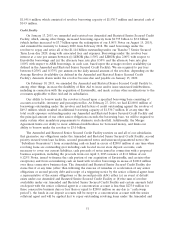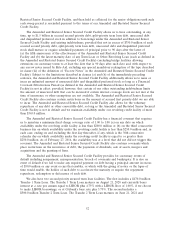Rite Aid 2016 Annual Report Download - page 61
Download and view the complete annual report
Please find page 61 of the 2016 Rite Aid annual report below. You can navigate through the pages in the report by either clicking on the pages listed below, or by using the keyword search tool below to find specific information within the annual report.20 basis point difference in the discount rate for the year ended February 27, 2016, would have affected
pretax income by approximately $2.0 million.
Lease termination charges: We record reserves for closed stores based on future lease
commitments, anticipated ancillary occupancy costs and anticipated future subleases of properties. The
reserves are calculated at the individual location level and the assumptions are assessed at that level.
The reserve for lease exit liabilities is discounted using a credit adjusted risk free interest rate. Reserve
estimates and related assumptions are updated on a quarterly basis.
Changes in the real estate leasing markets can have an impact on the closed store reserve.
Additionally, some of our closed stores were closed prior to our adoption of ASC 420, ‘‘Exit or
Disposal Cost Obligations.’’ Therefore, if interest rates change, reserves may be increased or decreased.
As of February 27, 2016, a 50 basis point variance in the credit adjusted risk free interest rate would
have affected pretax income by approximately $0.8 million for fiscal 2016.
Income taxes: We currently have net operating loss (‘‘NOL’’) carryforwards that can be utilized to
offset future income for federal and state tax purposes. These NOLs generate significant deferred tax
assets. Realization is dependent on generating sufficient taxable income prior to the expiration of the
loss carryforwards.
We regularly review the deferred tax assets for recoverability considering the relative impact of
negative and positive evidence including our historical profitability, projected taxable income, the
expected timing of the reversals of existing temporary differences and tax planning strategies. The
weight given to the potential effect of the negative and positive evidence is commensurate with the
extent to which it can be objectively verified. In evaluating the objective evidence that historical results
provide, we consider three years of cumulative pretax book income (loss).
We establish a valuation allowance against deferred tax assets when we determine that it is more
likely than not that some portion of our deferred tax assets will not be realized. There have been no
significant changes in the assumptions used to calculate our valuation allowance over the last three
years.
On an ongoing basis, we will continue to monitor our deferred tax assets to ensure their utilization
prior to their expiration. If we determine that we would be able to realize our deferred tax assets in the
future in excess of their net recorded amount, we would make an adjustment to the deferred tax asset
valuation allowance, which would impact the provision for income taxes.
We recognize tax liabilities in accordance with ASC 740, ‘‘Income Taxes’’ and we adjust these
liabilities when our judgment changes as a result of the evaluation of new information not previously
available. Due to the complexity of some of these uncertainties, the ultimate resolution may result in a
payment that is materially different from our current estimate of the tax liabilities.
Litigation reserves: We are involved in litigation on an on-going basis. We accrue our best estimate
of the probable loss related to legal claims. Such estimates are based upon a combination of litigation
and settlement strategies. These estimates are updated as the facts and circumstances of the cases
develop and/or change. To the extent additional information arises or our strategies change, it is
possible that our best estimate of the probable liability may also change. Changes to these reserves
during the last three fiscal years were not material.
Revenue recognition for our Pharmacy Services segment: Our Pharmacy Services segment sells
prescription drugs indirectly through our retail pharmacy network and directly through our mail service
dispensing pharmacy. We recognize revenues in our Pharmacy Services segment from (i) our mail
service dispensing pharmacy and (ii) prescription drugs sold under retail pharmacy network contracts
where we are the principal using the gross method at the contract prices negotiated with our clients,
primarily employers, insurance companies, unions, government employee groups, health plans, Managed
61
























